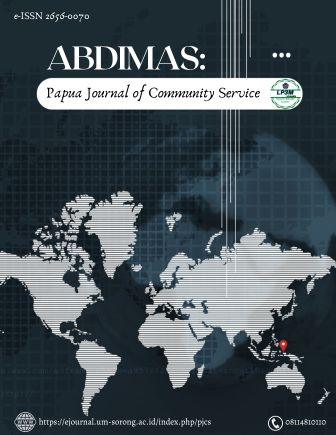Submissions
Author Guidelines
Online Submission Procedure
By submitting to abdimas: PJCS, authors attest that:
- The submission is an original work, free from any form of plagiarism (text, data, and figures).
- All received manuscripts will be subjected to a similarity checking process
- The submission has not been previously published, nor is it under consideration by another journal.
- The submission has been approved by all co-authors and relevant authorities (e.g. an institution or sponsor).
- The manuscript has been (to the best of the authors abilities) written in good English or Bahasa Indonesia and is free of grammatical errors. However, it is highly recommended to submit the manuscript in English. It has been checked with a proofreading tool (e.g. Grammarly) and, if possible, proofread by a language editor.
Submissions to PJCS should be through its online submission system. There are no strict formatting requirements for the initial submission, as long as the article structure conforms with our guidelines (see the manuscript structure section below). Manuscripts that advance to the revision stage will then be required to be formatted appropriately (see the formatting section). This enables authors to focus on the scientific content of their manuscript, along with speeding up the articles processing time.
Author(s) data. The submitting author is required to complete the author(s) data during the submission. Please ensure that the affiliation addresses are complete and written exactly as they appear on the manuscript.
Manuscript metadata. Please complete at least the following information related to the manuscript:
Title: Fill in the manuscript title field in sentence case.
Abstract: Paste the abstract into the abstract field; make sure that the formatting is consistent with the manuscript (e.g. superscript and italics).
Keywords: Provide a maximum of 3 words/phrases, separated by semicolons.
References: References should be written in accordance with the APA (PJCS chosen reference style), but with the journal name written in full (not abbreviated). Separate each individual reference with a blank line.
Manuscript Structures
Title. Use a concise and informative title in sentence case, with a maximum of 14 words.
Affiliation. Provide the full postal address of each authors affiliation, including the street name and number, city, ZIP code, and country.
Abstract. Should consist of a single paragraph of no more than 250 words. Provide the background and objective of the paper, its principal results, and its conclusions. Avoid using abbreviations and citations.
Keywords. Include a maximum of 3 keywords
Keywords. Include a maximum of 3 keywords or phrases, arranged alphabetically and separated using semicolons (;). Use specific, relevant terms that do not appear in the title, so that the article is easier to find in search engines. Do not use terms that are too general or too long.
Introduction. This section should briefly explain the background of the study, provide a short review of the pertinent literature, state the originality of the research, and state the research objectives. This section also covers the factual and actual problems, challenges, or requirements needed by the community which related to the research purposes.
Research Methodology. Combine the methods and procedure used into one narrative passage. Enough information should be provided to enable repetition of the research. For commercial sources of the materials, the name of the company, and the town and country in which they are located should be indicated. Methods already published should be indicated by a reference, with only the relevant modifications described here
Results and Discussion. Describe the outcome of the study. Data should be presented as concisely as possible, and in the form of tables or figures if appropriate, although very large tables should be avoided. If needed, this section can be combined with the Discussion section into a Results and discussion section.
Discussion. This section should be an interpretation of the results of the work (not a repetition of them) in the context of previous research. Avoid excessive referencing of published literature. If needed, this section can be combined with the Results section into a Results and discussion section.
Conclusions and Implication. The main conclusions of the study may be presented in a standalone Conclusions section or included as a subsection of the Discussion section.
Acknowledgments. Acknowledge anyone who contributed to the research, as well as any funding or grants received in support of it. The names of funding organizations should be written in full, along with the grant numbers, if available. List any individuals who helped you during the study (e.g. assistance with study design or analysis, or guidance through a study area), or writing of the article (e.g. providing advice on the language, editing, or proofreading the article).
References. List all items alphabetically. Literature cited during the construction of the paper is included in the bibliography. For the purposes of efficiency and conciseness, avoid using more than 15-40 references and less than 10, consist of 60% journal references and 40% book references. Journal references should be at least 5 recent years while booking references. PJCS uses an APA 6th Edition (American Psychological Association) format.
All manuscripts received using Mendeley software, Zotero and the other similar applications




